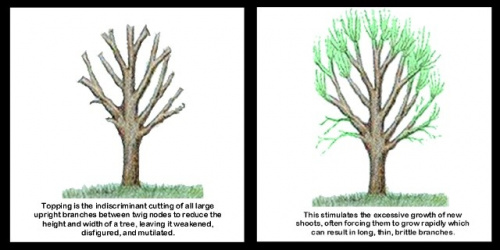What Is Tree Topping VS Crown
- June 5, 2022
- Landscapers

What Is Tree Topping VS Crown Reduction Safe?
What Is the Tree Topping VS Crown Removal safe?? We’ve all heard about the debate over crown reduction, but are both procedures equally safe? Tree topping results in unsightly stubs and exposes the tree to disease and fungi. Also, it can lead to starvation and insect infestations. Read on to learn about the pros and cons of both tree topping and crown reduction.
Tree topping causes unsightly stubs of branches
The procedure of tree topping creates unsightly stubs on the ends of the tree’s branches. Besides making the tree look unsightly, the process also exposes the tree’s stubs to disease and fungus. This is because trees’ foliage helps them to protect the tree from hot, direct sunlight. Cutting off large portions of the tree’s crown exposes the exposed wood to high temperatures and exposure to direct sunlight, which damages the bark. If the stubs are not removed, decay and insect invasion speed up the process.
The resulting cavity weakens the entire tree. Tree topping removes so much of the crown, disrupting the crown-to-root ratio. As a result, the internal branch tissue becomes exposed to the sun, reducing its ability to produce food. A topped branch’s wounds are large and poorly attached. They are also prone to breakage, especially in windy weather.
Another problem with
tree topping is that it weakens the branches that have been cut. The result is unsightly stubs on the trunk, which can become dangerous in a storm. It can also lead to the development of fungal decay and insect infestation. Tree topping also destroys the natural form of the tree. It also causes unsightly stubs on the trees’ branches.
Toppers also open the door for rot, and they often fail to protect the collars on the branches. The stubs are also not protected from decay organisms, making the tree prone to invasion by insects and diseases. Because of its vulnerability, a weakened tree is likely to fail quickly and may be damaged for years to come. So, tree topping is not an effective pruning technique.
Toppers often remove more than 50 percent of the leaf-bearing crown of a tree. This method creates unsightly stubs on the branches that were once covered in leaves. The leaves provide the tree with essential carbohydrates, but it also causes the leaves to die and turn brown. Moreover, the once-shaded bark of the canopy becomes exposed to sunlight, and the stubs will attract wood-boring insects.
It exposes the tree to decay fungi
If you’re considering a tree surgery, whether it’s better for your tree is one of the most controversial in the gardening world. Tree topping and crown reduction both expose the tree to decay fungi and bacteria, which can lead to serious problems. First, topping leaves the tree’s formerly-protected bark exposed. Additionally, the removed leaves can’t callus over, leaving them open to decay fungi and insect attacks. Finally, tree topping cuts off the tree’s foliage, which reduces the tree’s ability to capture sunlight and convert it into glucose, which can lead to decay.
Wood-decaying fungi often enter trees through large pruning wounds. This opens the tree up to the fungi, which can destroy the sapwood and the heartwood. The decay fungi then spread through the tree, affecting large areas of the tree. Some of these fungi have the ability to kill the bark. The first step in preventing decay is to identify the type of decay fungi. There are a number of them.
Another benefit
of crown reduction is that it leaves the tree’s branch-ends longer. When the “stub” is left long, it will grow back. This delay is
. If the branch is allowed to grow, most living branches will sprout. Delaying the removal of the “stub” will prolong the decay fungi’s attack time.
Both methods of crown reduction and tree topping expose the trees to decay fungi. Decay fungi attack wood in the central core of trees, the heartwood and sapwood. When conditions are favorable, these fungi can cause extensive decay within a month or two. The resulting rotting wood weakens the tree’s structure and makes it unstable. Even if the decay fungi are not visible, it’s possible to notice a decaying tree when the bark is cut or a cavity forms.
It causes insect and disease infestations
The first question you should ask when comparing tree-topping versus crown reduction is which one is worse for the tree. In addition to making the tree weaker and more susceptible to disease and insect infestations, topping leaves a deep wound in the trunk. While a small wound may heal, a large one could cause the tree to become extremely weak, prone to falling, and susceptible to infestation by insects. In addition to these issues, tree topping can lead to severe damage to the bark of the tree, making it more vulnerable to disease and insect infestations.
The other problem with tree topping is that it can cause the tree to lose up to 100% of its leaf bearing crown. This leaves the tree starved and less energy to defend itself against invasion. Trees are extremely sensitive to this stress, and in response, will send multiple shoots from latent buds beneath the cut. Often, these sprouts will not be strong enough to grow into a full, natural-looking crown.
The second problem
related to crown reduction is the onset of a vascular wilt. This can occur as a result of several causes, including structural damage to the tree or soil compaction. Plant-growth regulators can also delay the time between pruning. Tree topping is not recommended for big trees, because it weakens the tree and can cause more problems in the future. Therefore, if you’re unsure about which one to choose, contact a Certified Arborist for advice.
While tree topping is a temporary solution, it’s a costly mistake in the long run. Trees that are too large will require extra care to survive, and ultimately have to be removed. Crown reduction is a more conservative alternative that involves reducing the canopy of a tree. Tree crown reduction will reduce the tree’s overall size, which makes it less susceptible to disease and insect infestations.


